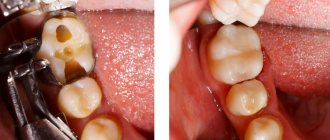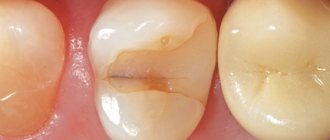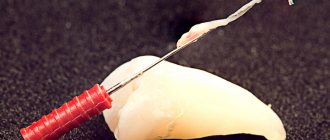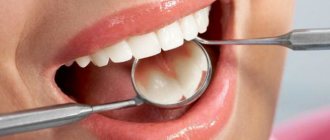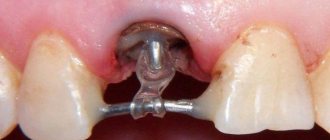The best remedies for toothache
There are many ways to quickly relieve pain at home if there are no pills. Some of them can be used immediately, while others make sense to prepare in advance.
Top 10 funds
- Rinse with a warm (not hot or cold!) solution of salt and soda. Dissolve one teaspoon of salt and soda in a glass of water, rinse every 20-30 minutes. The pain will go away gradually.
- Apply a crushed clove of garlic. You can use garlic mixed with salt.
- Hydrogen peroxide solution You can use a ready-made solution directly from the pharmacy, but it has a specific taste. For this reason, it is better to dissolve 1-2 tablespoons in a glass of water. Do not swallow – the substance is a strong oxidizing agent.
- Strong alcohol Rinse your mouth vigorously with a sip of vodka or cognac on the affected side. In the case of an open canal, a sharp pain may initially appear, which will quickly subside. Not to drink.
- Ice Take a piece of ice from the freezer and wrap it in a napkin or towel. Apply to the sore cheek. If there is no ice, take a piece of frozen meat. It is important to avoid hypothermia.
- Infusion of chamomile or sage Chamomile is brewed at the rate of one or two tablespoons per glass of boiling water and infused. Sage is taken in the same proportions and kept in a water bath for 15 minutes. Rinse your mouth with warm infusion continuously for 20 minutes. To consolidate the effect, the procedure is repeated after 15 minutes. The method is one of the most effective.
- Apple cider vinegar is also a good pain reliever. Moisten a piece of cotton wool and apply it to the tooth.
- A time-tested method is to place a piece of unsalted lard between the cheek and the sore area. If the lard is taken out of the freezer, the cut piece should be warmed to room temperature.
- Ketorol, one of the best drugs that relieve pain. There are restrictions on quantity - no more than three tablets per day. It is not recommended to take for peptic ulcers, gastrointestinal diseases, shortness of breath, bronchospasm, stroke. Pregnancy and breastfeeding are also contraindications.
- Analgin Despite all the negative attitudes towards it, it will quickly help relieve toothache for a while. Not recommended for pregnant and lactating women.
- Raw beets Apply a piece to the sore spot.
- Propolis tincture Moisten a cotton swab with the solution and apply to the tooth, but not to the gum (you may get burned). The product is not suitable for those who have an allergic reaction to honey and its products.
- Take a small onion, chop it very finely. Wrap the resulting mass in gauze (cambric or washed thin chintz) and place it in the ear, which is located on the other side of the diseased area.
- Valerian or horse sorrel leaves. Picked leaves can be chewed or applied to the tooth. The product is a good help when relaxing outdoors in the summer.
- Peppermint The plant has excellent analgesic and vasodilating properties. To reduce pain, just chew the leaves.
- Vodka with garlic Grate two cloves of garlic and mix with 30 ml of vodka. Rinse your mouth vigorously on the affected side. Be sure to spit out the mixture.
- Aspen decoction Pour boiling water over a tablespoon of small wood chips (a little more than a glass), boil for 15 minutes, leave for at least half an hour. Then rinse your mouth every 15-20 minutes until the pain stops completely.
- Rinsing with oak bark decoction is prepared in the same way as aspen decoction.
- Clove oil Apply a cotton wool soaked in oil to the tooth.
- Fir oil A few drops should be applied to a cotton swab or disk and applied to the sore spot. For “blurred”, non-localized pain, you can inhale the vapor.
- Tea tree oil We also apply it to a cotton swab and apply it to the problem area. If necessary, we do a mini-inhalation.
- Plantain Take a fresh plantain leaf and rinse it well. You can knead it, you can chew it. Apply the resulting pulp to the sore spot. As an option, brew the herb (1 tablespoon per glass) and rinse with a warm solution.
- Plantain root Pull out the plantain bush, rinse the roots well and dry. Place a few roots between the tooth and cheek. The second option is to insert the root into the ear canal on the sore side.
- Cinnamon Pour cinnamon powder into warm water to form a dense mass. Apply the resulting paste to the tooth and adjacent gum. Improvement is noticed almost immediately, and after a few minutes the pain goes away.
- Turnip decoction Pour boiling water over two tablespoons of chopped vegetable and simmer for 15 minutes over low heat. Cool until warm and rinse.
- Mint drops Moisten a cotton pad or cotton ball and apply to the tooth.
- Camphor oil is great for helping not only with toothache, but also with gum abscesses. The moistened cotton wool is applied to the tooth or gum. It draws out pus very quickly.
- Place a clove of garlic on the wrist on the side opposite the painful area. Wrap it with a bandage or secure with a bandage.
- Onion peel decoction Remove the peel from a medium onion and pour boiling water over it. Leave until the solution becomes warm. Start rinsing. The product is really very effective - three procedures every 20-30 minutes are enough.
- A piece of incense You should try to place it in the hole of the tooth.
- Dissolve 3 tablets of mumiyo in a glass of warm water, rinse your mouth
- Heart drops Corvalol, valocordin, valoserdin. Apply a moistened piece of cotton wool to the sore tooth.
Folk remedies
Folk help for tooth root abscess
It is possible to determine that the pain syndrome is caused by a tooth root abscess by the presence of swelling on the side of the diseased tooth. A lump (flux) is usually felt in the root zone. The pain is constant, pulsating and bursting, and body temperature may rise.
Folk remedies against toothache caused by gumboil are aimed not only at pain relief, but also at slowing down the inflammatory process. However, with a developing root abscess, only a doctor using special equipment can determine the extent and stage of the inflammatory process and prescribe adequate treatment.
Compress
An anti-flux compress helps relieve pain and reduce swelling. To prepare it, a teaspoon of sugar is mixed with a teaspoon of extra salt and half a teaspoon of ground black pepper. Then three percent table vinegar in the amount of one teaspoon is added to the mixture - you should get a thick paste.
When all ingredients are added, the mixture is heated in the microwave or over heat until thickened. After the mass has cooled, it is applied to the sore spot.
Gargling with sage decoction
To prepare the rinse solution, you need to combine half a liter of boiling water with 2 tablespoons of dried sage and leave the mixture covered until it cools completely. After the liquid has cooled, the broth should be strained and divided into 2 servings. You need to use it twice a day. After the first rinse, the intensity of the pain will decrease, after the second, there will be a slight decrease in swelling.
Blue clay
Blue clay helps fight swelling more than it serves as a pain reliever. During initial use, the pain may intensify and not stop within the first 5-10 minutes after application.
A small piece of clay wrapped in sterile gauze is used. Clay is applied not to the tooth itself, which hurts, but to the gum. A reduction in swelling is visible after the first use. And the pain goes away gradually: as the inflammatory process decreases.
Onion juice
A cotton swab dipped in raw onion juice is placed on the sore tooth. You can squeeze juice from an onion in two ways: using a juicer or chopping the onion in a blender and squeezing out the juice using gauze. You need to keep the onion lotion on the tooth until the pain stops completely.
Medicines to relieve toothache
Pharmacological drugs will help relieve pain faster and more effectively than folk remedies. But there are some disadvantages here - contraindications and allergies to any of the components.
Each personal first aid kit has its own set of painkillers. Some are accustomed to using state-of-the-art, expensive drugs, while others still prefer familiar and familiar means. Also read our article about the best tablets for toothache.
Good help to get rid of toothache:
Psychological techniques
Here you will have to concentrate a little and try to pull yourself together.
Massage
You should start with the hand that is located on the side of the diseased tooth.
Prepare ahead of time at home or let it sit just in case
Not a single folk remedy, even the best one, can eliminate the source of pain. As a temporary option, wait until the morning if you get it at night, or as a pain reliever for acute symptoms.
Controversial methods of traditional medicine
The most famous folk remedies that relieve toothache at home are all kinds of lotions and applications. This includes lard, beets, propolis, vodka, and even pieces of ice. As reflexology, it is suggested to apply a magnet to the cheek, a heating pad to the back of the head, and garlic to the hand opposite the painful tooth. There is even advice that pressing a certain point on the carotid artery will help get rid of toothache.
The effectiveness of these products is questionable, and the safety of use does not stand up to criticism. At best, these remedies will not give results, and at worst, they will cause the opposite effect and add to health problems.
In people with vascular diseases, applying a heating pad to the back of the head can cause a worsening of the condition, even leading to a stroke. Ice can cause an attack of pain if the enamel is damaged, and with flux, it can provoke a sharp round of inflammation. Beets, lard and a magnet will work as a placebo at best.
When using folk remedies for tooth pain at home, it is important to remember that they are not a cure and cannot eliminate the disease that triggered the attack. They can relieve pain, remove or reduce the intensity of swelling and somewhat slow down the inflammatory process, so it is advisable to use them exclusively as temporary pain relief before visiting the dentist. It is impossible to equate folk recipes for toothache with full-fledged treatment that guarantees a prolonged effect.
Category Medicines / drugs Published by Mister stomatolog
What to do if only cold water helps with pain
At a certain stage of the disease (in particular, with gangrenous pulpitis), rinsing with cold water can help. Please note, under no circumstances is it icy. Rather, we are talking about water at room temperature, which is perceived by our body as cold.
It will not be possible to completely remove toothache, but it is quite possible to alleviate your condition a little. When cooled, tissue swelling decreases slightly and the feeling of fullness goes away. When heated, the pain occurs again, some feel it with a vengeance. Regular rinsing every 5-10 minutes will help you get to the doctor, but will not remove the cause.
It is not recommended to use ice water for such purposes, since with a large temperature difference, cracking of the enamel is possible. This effect is especially unfavorable in cases of hypersensitivity. You can try to apply any cold object to the cheek on the sore side, but, again, not for long, to avoid possible inflammation of the trigeminal nerve (and this is another and also not a very funny story).
Important! Do not heat your cheek on the sore side and do not rinse your mouth with hot water. It's not guaranteed to help, and it's sure to make things worse.
What to do if your tooth hurts at night
Physiologically, the most difficult time for a person is from midnight to 5 am. By evening, the level of corticosteroids in the blood decreases, which reduce pain. That is, by night a person is left alone with himself, in this case with his pain.
Unbearable night pain is characteristic of pulpitis. In a horizontal position, blood rushes to the head, increasing pressure on the nerve roots. The “half-sitting” position will help ease the situation a little. Raise the pillow higher so that your head is higher than your torso.
It is unlikely that shallow caries will make itself felt at night, but if you have periodontitis, periodontitis and gingivitis, such manifestations are quite real. The pain can be pulsating, localized, and accompanied by an additional burning sensation. In the worst cases, it feels like half your head hurts.
Mild pain may occur the first night after a nerve or tooth is removed. Take a tablet, rinse your mouth with a soda solution - these simple steps should help you quickly. You can also use folk remedies - clove oil, apply garlic.
As an option for severe pain, apply something cold to your cheek. Ice or even a piece of frozen meat will do. The only thing is to wrap it in a cloth or towel. Take any of the analgesics - Nurofen, Analgin, Ibuprofen, Nise, Tempalgin, Pentalgin, Ketorol.
Need to know! No-shpa tablets do not help against toothache; there is no point in taking them.
In what cases should you consult a doctor immediately?
In some situations, not taking action can have a detrimental effect on your health. Turning to folk remedies or tablets from your home medicine cabinet will result in a loss of time and a deterioration in your condition.
If you notice at night:
- temperature increase;
- severe swelling on one side of the face;
- difficulty breathing and swallowing;
- cardiopalmus;
- loss of sensation in the affected part of the head
We call an ambulance or look for a clinic that provides 24-hour dental care.
Important! Breathing problems are especially dangerous, which may indicate incipient swelling of the larynx.
Other causes of night pain
Quite often a person perceives pain as toothache, although its cause lies in diseases of a fundamentally different nature. This pain also appears or intensifies at night or late in the evening.
We are talking about diseases such as:
- Inflammation of the trigeminal nerve.
The branches of the nerve are located very close to the roots of the teeth; when inflammation occurs, pain similar to toothache occurs. The nature of the pain is nagging and at times quite strong, localized or spreading throughout the jaw. - Sinusitis, sinusitis, otitis.
Accumulated in the sinuses and tissues, purulent accumulations put pressure on the roots of the teeth, causing discomfort. Quite often, a similar situation occurs in children who find it difficult to determine the source of pain. - Stress.
Night toothache occurs as a reaction of the body to constant nervous tension.
Only a doctor can determine the cause. To make a correct diagnosis, you will still have to visit a dentist to rule out diseases of the teeth and oral cavity. Therefore, we recommend not to delay visiting the doctor in order to avoid possible complications as much as possible.
What to do if pills don't help
If you still reach this state or the pain arose suddenly (this no longer matters), painkillers do not help in any quantity, look for a way out of the situation. It is better if you still consult a doctor.
When medications do not help, this means that the inflammatory process has reached such an extent that the tooth must be opened immediately. Wild pain, this is how everyone who has experienced it characterizes this condition. Nothing will help here - neither compresses, nor folk remedies, nor tablets. The accumulated pus puts pressure on the tissue, the pain becomes unbearable.
There are 24-hour dental services at night; find the phone number on the Internet, call and arrange a visit. Toothache is dangerous because it completely exhausts a person. You shouldn't bring yourself to this state.
If you think that you can hold out until the morning or until the appointed time, try to distract yourself or apply psychological techniques on yourself. It's better if you are on the move. Some active actions will shift your attention, and you will feel a little better.
If you notice that your medications are no longer working, you should no longer take them. An overdose and an allergic reaction are possible, in which case you will need to call an ambulance.
Treatment at the initial stage is faster and cheaper
When treating caries at the initial stage of its development, anesthesia is not required, since the procedure itself is painless, and the filling will cost less due to the use of a small amount of material. In addition, you will spend much less time: the doctor will fill a small hole in a tooth in 15-30 minutes, while he will have to treat the entire tooth and install a large filling for at least an hour. It all depends on the condition of the dentition and the degree of complexity of the operations performed.
Now you have learned why it is necessary to treat caries, even when your teeth do not hurt. It is possible to prevent serious oral diseases and maintain healthy teeth for many years if you treat your teeth in a timely manner. And one should not neglect the rules of hygiene and preventive examinations at the dentist. The beauty of your smile largely depends on you!
Why does a dead tooth hurt?
If you have a dead (pulpless) tooth immediately after the anesthetic wears off, this is normal. Pain of moderate to severe intensity can last from 1 to 4 days after removal of the nerve. Unpleasant symptoms can be relieved by taking a painkiller tablet. A competent doctor immediately warns the patient about possible pain and immediately recommends medications. As a rule, this is analgin, ibuprofen, ketorol.
Another reason is the severe stage of periodontitis, causing purulent tissue lesions. Painkillers help only temporarily, you will have to go to the doctor. But this situation also arises in the absence of hygiene and neglect of the disease.
In all other cases, pain in a dead tooth is a pathology caused by incomplete removal of the nerve, poor cleaning of the canals and errors associated with filling. It may manifest itself slightly when biting and pressing, or it may be an immediate shooting localized pain. In some cases, it occurs after a person is very cold or has a cold.
Important! There is only one way out - the sooner you get to the doctor, the better for you. To survive the time “before the doctor”, you can apply a cold object to your cheek. Tablets do not help much in this situation.
Why is treatment of caries, if the tooth does not hurt, still necessary?
When teeth are affected by caries, they can make themselves felt at the most inopportune moment. Imagine the situation: you are on vacation, and you are going to visit another country or are already there, or went to another city or wanted to relax in nature, and the nearest dental clinic is several hours away from you, and your tooth hurts a lot, your cheek is swollen, and No drugs relieve the symptom. What should I do? Of course, it would be better to treat teeth at the initial stage of caries development, before they begin to become inflamed, before acute pain or even a cyst appears. The current situation requires an urgent search for a dentist. Naturally, if you are staying in a foreign country or city, the cost of services will be much higher, and one can only guess how high-quality and durable the result you will get.
One of the important reasons why it is very necessary to treat caries when teeth do not hurt is the possible consequences of untimely treatment.
If the tooth is loose and hurts
What to do if the tooth not only hurts, but also becomes loose - we try to relieve the pain using any of the listed methods (tablets, gels, rinsing, folk remedies). And we are planning a visit to the doctor. Perhaps carious processes have begun with simultaneous loosening of the tissues around the tooth. If you get there in time, he can be saved. Similar manifestations are possible with periodontitis, periodontal disease, and gingivitis.
Be careful. When carrying out manipulations, try to be extremely careful to prevent further loosening.
Depending on the diagnosis, the doctor will prescribe treatment, including antibiotics, vitamin therapy, and physiotherapy.
Types of anesthesia for painless dental treatment
Depending on the complexity of the upcoming dental intervention, the doctor can offer the client three options for pain relief:
Application. The anesthetic drug is applied to a gauze pad and applied to the area of the upcoming dental intervention. This method is not able to eliminate severe pain, therefore it is relevant only when helping children, for example, when removing milk units before injecting the medicine.- Infiltration. It is a full-fledged injection, but the medicine is not injected very deeply. The medicine “turns off” peripheral nerve endings. This is enough to painlessly eliminate caries (including deep caries), pulpitis and other diseases.
- Conductor. This type of anesthesia affects both small nerve branches and large clusters, trunks and canals of nerves. Having given an injection, the doctor immediately makes half of the jaw insensitive. This allows you to painlessly perform complex surgical operations, removal, and treat inflammatory pathologies of the oral cavity.
If your wisdom tooth hurts
In cases where a wisdom tooth begins to hurt, doctors recommend removing it immediately. If he starts to cut himself, then you can help yourself a little on your own. The process can take almost a year, and the gums may become inflamed, the cheek may swell, and severe pain may occur—it feels as if the entire jaw is being broken out. The temperature can also rise to 38-40°C.
- Within 4-5 days you can take analgesics in accordance with the indicated dosage.
- You can use Metrogil Dent or Dentinorm.
- Regularly, several times a day, rinse your mouth with decoctions of chamomile, sage, calendula, and oak bark.
- A warm solution of salt and soda (one teaspoon per glass of water) will help.
Care after root treatment
It is very important to take good care of your teeth, especially oral hygiene during the recovery period after root canal treatment. Once treatment is complete, your tooth will be completely restored and should be pain free, although it may be tender for a few days after root treatment.
In most cases, you can prevent the need for root canal treatment by:
- Maintaining good oral hygiene
- Regular visits to the dentist
- Avoiding large amounts of sugary foods
- No bad habits - quit smoking if you smoke
If your tooth hurts after nerve removal
Even several hours after removal of the nerve, pain may be felt in the damaged tooth - when pressing, when biting, or slightly throbbing. This is a normal reaction of the body to intervention.
What to do:
- Take one or two tablets of any painkiller - analgin, baralgin, tempalgin, pentalgin, dexalgin, paracetamol, nise.
- You can carefully anoint the gums with one of the gels - Cholisal, Metrogyl Denta, Kamistad, Solcoseryl.
If the pain does not subside or even intensifies, you will have to return to the doctor.
Why do my teeth hurt?
The main causes of toothache include:
- Caries.
The initial stage is characterized by the destruction of the upper tooth tissues. The pain occurs periodically or one-time - the tooth reacts to pressure, cold and hot. - Deep caries.
The middle tissues of the tooth are affected, the pain becomes more prolonged, aching or throbbing. - Pulpitis.
The result of untreated caries. A nerve has been hit. The pain is severe and incessant. - Periodontitis.
Inflammation of the tissues around the roots of the teeth. It occurs as a consequence of pulpitis or after erroneous medical procedures. The pain is acute, intense. - Residues of food stuck
between teeth, even healthy ones. First there is a feeling of discomfort, then a pressing pain that can cover the entire jaw. Use dental floss or metal (dental) tape.


